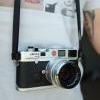First test roll from my M6
-
Recently Browsing 0 members
- No registered users viewing this page.
-
Similar Content
-
First SL lens
By Orson,
- 9 replies
- 431 views
-
- 1 reply
- 101 views
-
- 1 reply
- 99 views
-
- 3 replies
- 378 views
-
- 3 replies
- 1,057 views
-




Recommended Posts
Join the conversation
You can post now and register later. If you have an account, sign in now to post with your account.
Note: Your post will require moderator approval before it will be visible.